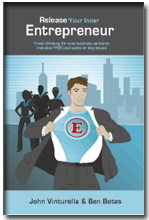Introduction of Crowdfunding to South Africa
With the introduction of crowdfunding to South Africa recently through StartMe, which helps entrepreneurs, creative projects and community initiatives to raise money, normally at levels where angel investors and venture capital firms don't get involved in,we can safely assume that the business finance landscape has changed for good.
With banks increasingly hesitant to support these projects especially where there may be no track record of success as proof, have we finally found a way to address this crucial need of money for start-up projects to succeed?
I’ve often said that I suspect that over the average person’s lifetime they will have probably spent about three years untangling headphones. It’s exasperating! When I heard about Flux Headphones that use tiny magnets to keep cords untangled, I was intrigued not just by their ingenuity but by the way the inventor is trying to bring the product to market. It’s called crowdfunding and it's just the thing for inventors in San Jose and the rest of Silicon Valley.
Crowdfunding uses the vastness and the power of the Web for entrepreneurs to solicit donations from people to fund their idea. Other crowdfunding sites for entrepreneurs include Kickstarter and Peerbackers. Crowdfunding is also used to raise money for political causes, to support artists, indie films and for charities. According to Wikipedia, crowdfunding can be used to attract business investors giving small amounts, in exchange for equity in the fledgling business, under a provision in the federal JOBS Act, which was signed into law in April by President Barack Obama.
Matt Scandora, the inventor of Flux Headphones, pitched his idea on the Web site Fundable.com, which features his product and other products and services by entrepreneurs seeking funding. It contains a two-and-a-half minute video on Flux Headphones, notes the amount of money Scandora is hoping to raise -- $45,000 -- the amount raised so far, $5,000 the last time I checked, and the number of days left for people to invest.
Unlike under the federal law, investors in Fundable.com do not get an equity stake in the business; instead they earn “rewards,” which can be redeemed for gifts from the entrepreneur. It could be something as token as a t-shirt or a free version of the product being developed, like the tangle-free headphones.
By the way, Flux Headphones work with several tiny magnets embedded in the main part of the cord before it splits off into the two ear buds. The video shows a runner wrapping the cord around their wrist when not in use and then unwrapping it when they plan to use the headphones. Flux Headphones only work on Apple products, including the iPhone, iPad and iPod.
Fundable only awards money pledged by backers if they meet their fundraising goal, which forces entrepreneurs to set realistic goals for a particular milestone, such as beginning production of the Flux Headphone. It does allow entrepreneurs to keep extra money if donations exceed their stated goals.
Another crowdfunding site called Kickstarter has the same approach as Fundable. Kickstarter’s mission is to fund “projects such as making an album, a book, or a work of art,” according to its Web site. While it is not intended to start a business, a project can include creating a product. It funds projects in a wide number of areas including art, dance, fashion, film, music or technology. It also has a long list of projects it won't fund, including political candidates, pornography, firearms or multi-level or pyramid marketing schemes, just to name a few.
So as South Africa now finally has its own crowdfunding platform, will we see the same level of involvement from the public in contributing to these projects as we have seen elsewhere, or are we as South Africans just not quite at the stage where we are happy to support someone who we have not quote yet met in person?
Labels: angel investors, business finance, crowdfunding, venture capital








